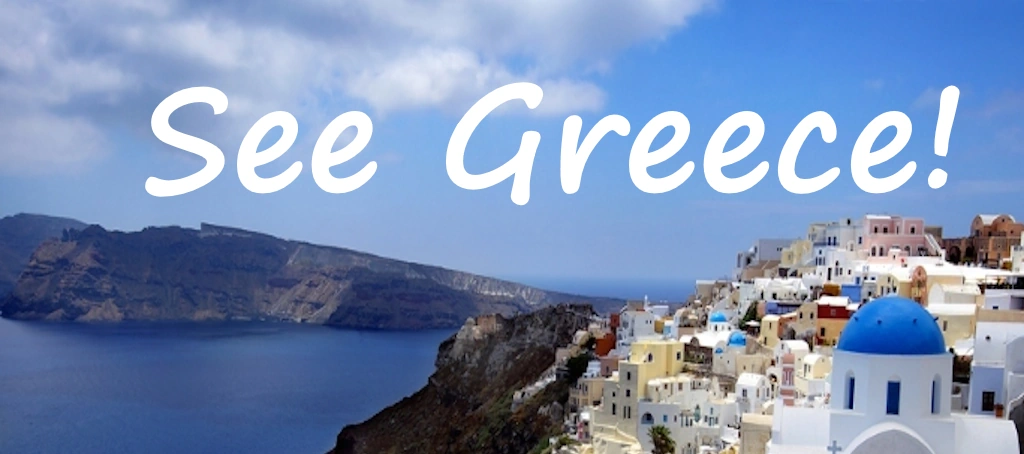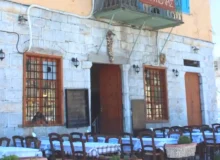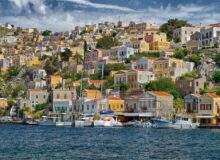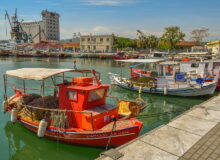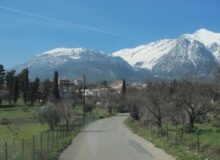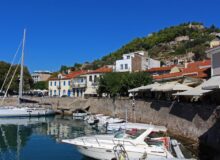Corinth
Corinth has four aspects to it, which are the Corinth canal, the modern town of Corinth, nearby Ancient Corinth, and above that Akrokorinthos or Upper Corinth.

The Corinth Canal
The Corinth (Korinthos) Canal is one of the great sights of Greece. With luck, you might be there when a ship is being steered between the narrow, sheer walls which stretch away in the distance to link the Gulf of Corinth with the Aegean Sea. The only way to see it – apart from taking a boat through it – is to take the main road from Athens onto the Peloponnese, which crosses over the canal. You can park and get out to have a lovely view down the canal, an engineering marvel which effectively turned the Peloponnese into a giant island.

Roman Emperor Nero (37-68 AD) first mooted the idea of cutting a canal through the isthmus so that ships could sail from Italy into the Aegean without going all the way round the Peloponnese. He performed the first symbolic excavation in person, using a silver shovel, but the task was never completed. Ships continued to sail up the Gulf of Corinth, unload their cargoes, , and have them carried the 3.5 miles (6 km) to a ship waiting on the far side rather than risk losing the cargo on the sometimes stormy circuit around the Peloponnese.
It wasn’t until 1893, after a total of 12 years work, that the 75-foot (23-metre) Corinth Canal was finally cut through, enabling boats to sail directly to Piraeus. The canal is still used, though less so these days as it isn’t large enough to take the latest super-tankers.
Modern Corinth
A few miles beyond the canal (if coming from Athens) is the modern town of Corinth, which detains few visitors except maybe as a refueling stop. It’s mainly an agricultural service town, and it’s interesting to know that it’s the centre of the Greek currant industry: the word ‘currant’ actually derives from the name Corinth. There are hotels and restaurants if you need to spend the night, but the charms of Nafplion are little more than an hour’s drive away, so head there for the evening.
Ancient Corinth

Beyond the modern town, the site of Ancient Corinth is to the south of the main road. Regular buses from modern Corinth also take visitors to and from the site. The site really comes to life as you walk around the well-preserved remains which are dominated by a Temple of Apollo from the 5th century BC. With its massive Doric columns, this is one of the buildings that the Romans left when they redeveloped the city as their provincial capital in 44BC.
The city was once home to 300,000 citizens and 460,000 more who were slaves – a total population bigger than modern-day Denver, Boston, or Washington DC. The smallest buildings are the ones that speak of the history: the remnants of shops, houses, and administrative buildings. The Peirine Fountain was a gift from Herodes Atticus, the wealthy Athenian, patron and friend of the Romans, and the spring beneath it still provides the water supply for the modern town of Corinth.

The Archaeological Museum on the site has a good display of remains found there. Some lovely mosaics, mostly dating from the second-century AD Roman period, are a good indication of the city’s wealth at that time. Domestic vases, pottery, and jewelry all give the collection a more human scale.
Upper Corinth
Overlooking the lower city from the hilltop 2.5 miles (4 km) away was Akrokorinthos, or Upper Corinth. To get here you’ll need a car or take a taxi from Corinth, and though it’s a bit steep you can hike it or bike it too. Akrokorinthos’s walls and spectacular views are the chief reasons to visit.
When you see the position the city commands, you realise its strategic importance and why it was refortified by every subsequent wave of invaders, including the Venetians, the Franks, and the Turks. The walls run for 1.25 miles (2 km) around the 60-acre (24-hectare) site, where you can find the remains of chapels, mosques, houses, fortifications, and the still-working Turkish Fountain of Hatzi Mustafa.
